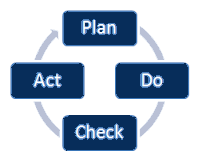Completing a health assessment is not a new endeavor for most local communities or states. Measurement can be a technical challenge, but monitoring health status is part what governmental public health organizations do in delivering the 10 Essential Public Health Services; most do it well.
The real challenge often comes after the assessment, when it is time to prioritize health improvement challenges, plan and implement solutions, and measure the impact over time. Successfully creating and implementing a community health improvment plan (CHIP) or state health improvement plan (SHIP) often means:
- Recognizing what initiatives, ideas, people, or organizations have not been effective in the past
- Going somewhere we have never been and doing things we have never done
- Collaborating and innovating
- Taking risks and remaining open-minded
This really is a lot to ask, so it is no surprise that it often loses momentum and falls by the wayside. Succeeding here requires much more than holding a meeting and checking off a box; it calls for authentic partnership in the service of strategic change. The Public Health Foundation (PHF) approaches this process through a quality improvement (QI) lens, incorporating QI tools and frameworks to help a public health organization interpret and prioritize the challenges embedded in health assessment data; plan the changes needed; and implement solutions to improve health status. The elements of this approach are summarized below.
Ready to put these steps into action in your community or state? Please contact Ron Bialek at (202)218-4420 or [email protected].
I. Articulate the Challenge
Understand the Forces at Work. Use a Diagnostic Force Field Analysis to pinpoint the driving and restraining forces, assets, opportunities, risks, and liabilities at work in your community.

Convene Partners. Use a Stakeholder Analysis,* Community Stakeholder Services Map, and Community Membership Analysis Matrix to bring experts and thought partners from clinical, law enforcement, public health, healthcare, and community-based organizations to the table as a multi-sector change coalition.
Map the Drivers of Change. Use a Population Health Driver Diagram to map the primary and secondary drivers of improvement to the opioid crisis in your community.
II. Plan the Change
Assess Options. Use a Solution and Effect Diagram* or a Prioritization Matrix* to isolate the solutions best-suited to your community’s health challenges and best-aligned with your partners’ capacity, competencies, and experience.
Make an Action Plan. Use Flow Charts* and Gantt Charts* to plan deployment and evaluation of solutions in your community.
III. Implement Solutions
Deploy Change Teams. Use Tools for Team Management to select your team members, assign roles, and maintain momentum as solutions are tailored and piloted to respond to your local opioid crisis.

Monitor and Improve Results. Use the PDCA Cycle to test solutions to secondary drivers. Use Data-centric Tools* to measure impact. Use a Start-Stop-Continue-Improve Matrix* to adjust your solutions until measureable improvements appear.
*Tool included in the Public Health Quality Improvement Encyclopedia